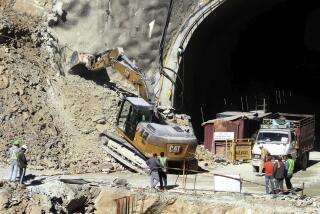Engineers struggle in latest effort to stem gulf oil leak
- Share via
BP engineers struggled Saturday to insert a 6-inch suction tube into a broken pipe a mile below the surface of the Gulf of Mexico in a second attempt to divert oil gushing from the well.
The delicate maneuver by robotic submarines was aborted Friday night when a metal frame enclosing the suction tube shifted, according to BP Chief Operating Officer Doug Suttles. The frame was hoisted back to a surface ship to be adjusted.
The operation resumed Saturday, but Suttles, speaking to reporters at a command post in Robert, La., cautioned that working 5,000 feet below the surface is “a challenge.”
If successful, the tube insertion could capture at most three-quarters of the leaking oil. BP would still have to cap a second leak.
Interior Secretary Ken Salazar, who has been wrestling with charges that his agency has been too cozy with the oil industry, flew over threatened wildlife refuges on the Louisiana coast and said at a news conference: “We feel the pain. We are frustrated.”
He said that Energy Secretary Steven Chu, who traveled to Houston last week with a group of scientists, is leading “the smartest people on the planet” to help with BP’s effort to stem the flow of oil after the Deepwater Horizon drilling rig explosion April 20.
Mindful of concerns on Capitol Hill that the petroleum giant might seek to avoid paying for all damages related to the massive spill, the administration on Saturday released a strongly worded letter from Salazar and Homeland Security Secretary Janet Napolitano to BP Chief Executive Anthony Hayward.
The letter requested “immediate public clarification of BP’s true intentions” and warned that the London-based company should not seek to dip into a federal oil spill trust fund established through industry taxes.
Based on BP’s assurances before congressional committees last week, the two Cabinet officials wrote that they understood BP would not invoke a $75-million statutory liability cap to refuse to pay full compensation for the spill. “And BP will not seek reimbursement from the American taxpayers, the United States government or the Oil Spill Liability Trust fund for any amount,” they wrote.
The letter was applauded by Sen. Robert Menendez (D-N.J.), a sponsor of legislation to retroactively raise the liability cap for individual accidents from $75 million to $10 billion. “There should be no legal wiggle room for oil companies that devastate coastal businesses and communities — now or in the future,” he said.
A BP spokesman, David Nicholas, told Bloomberg News, “What Secretaries Salazar and Napolitano are requesting is consistent with all our public statements on the matter.”
BP’s Hayward, speaking at the company’s Houston crisis center, told the British newspaper the Guardian, “We will fix it. I guarantee it. The only question is we do not know when.”
But he added that the leak, which is spewing at least 210,000 gallons of oil into the water daily — and perhaps more, according to some experts — should be put into context. “The Gulf of Mexico is a very big ocean,” he said. “The amount of volume of oil and dispersant we are putting into it is tiny in relation to the total water volume.”
The company has spent about $450 million responding to the spill, which occurred 48 miles off the Louisiana coast. Most of the oil has been kept offshore thanks to winds, currents and evaporation, as well as chemical dispersants that break it up to speed decomposition.
Still, the oil has now contaminated eight beaches in Louisiana, Alabama and Mississippi.
On Saturday, southern Louisiana was a patchwork of dark gray clouds, and 8-foot waves drove cleanup boats back to the docks. Intermittent heavy rains prevented skim operations, but 38 aircraft were able to fly over the spill to drop dispersant.
Times staff writer Raja Abdulrahim in Venice, La., and Jim Tankersley of the Washington bureau, reporting from Houston, contributed to this report.
More to Read
Sign up for Essential California
The most important California stories and recommendations in your inbox every morning.
You may occasionally receive promotional content from the Los Angeles Times.














